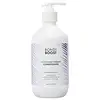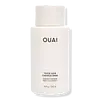What's inside
What's inside
 Key Ingredients
Key Ingredients

 Benefits
Benefits

 Concerns
Concerns

 Ingredients Side-by-side
Ingredients Side-by-side

Aloe Barbadensis Leaf Juice
Skin ConditioningBehentrimonium Chloride
PreservativeCetearyl Alcohol
EmollientGlycerin
HumectantCoco-Caprylate
EmollientPropanediol
SolventCaprylic/Capric Triglyceride
MaskingArgania Spinosa Kernel Oil
EmollientSimmondsia Chinensis Seed Oil
EmollientHydrolyzed Jojoba Esters
Skin ConditioningPanthenol
Skin ConditioningNiacinamide
SmoothingSodium Hyaluronate
HumectantCeramide Ng
Skin ConditioningRicinus Communis Seed Oil
MaskingVitis Vinifera Seed Oil
EmollientMacadamia Integrifolia Seed Oil
Skin ConditioningRosmarinus Officinalis Leaf Extract
AntimicrobialHydrolyzed Quinoa
Skin ConditioningHydrolyzed Adansonia Digitata Seed Extract
Biotin
AntiseborrhoeicParfum
MaskingPolyquaternium-7
Polyquaternium-10
Pentylene Glycol
Skin ConditioningCaprylyl Glycol
EmollientEthylhexylglycerin
Skin ConditioningCitric Acid
BufferingAloe Barbadensis Leaf Juice, Behentrimonium Chloride, Cetearyl Alcohol, Glycerin, Coco-Caprylate, Propanediol, Caprylic/Capric Triglyceride, Argania Spinosa Kernel Oil, Simmondsia Chinensis Seed Oil, Hydrolyzed Jojoba Esters, Panthenol, Niacinamide, Sodium Hyaluronate, Ceramide Ng, Ricinus Communis Seed Oil, Vitis Vinifera Seed Oil, Macadamia Integrifolia Seed Oil, Rosmarinus Officinalis Leaf Extract, Hydrolyzed Quinoa, Hydrolyzed Adansonia Digitata Seed Extract, Biotin, Parfum, Polyquaternium-7, Polyquaternium-10, Pentylene Glycol, Caprylyl Glycol, Ethylhexylglycerin, Citric Acid
Water
Skin ConditioningCetearyl Alcohol
EmollientBehentrimonium Chloride
PreservativeParfum
MaskingCetrimonium Chloride
AntimicrobialPanthenol
Skin ConditioningHydrolyzed Keratin
HumectantPersea Gratissima Oil
Skin ConditioningAlthaea Officinalis Root Extract
Skin ConditioningDimethicone
EmollientAmodimethicone
Butyrospermum Parkii Butter
Skin ConditioningPolyquaternium-37
Dicaprylyl Carbonate
EmollientLauryl Glucoside
CleansingDivinyldimethicone/Dimethicone Copolymer
C11-15 Pareth-7
EmulsifyingLaureth-9
EmulsifyingGlycerin
HumectantTrideceth-12
EmulsifyingC12-13 Pareth-23
CleansingC12-13 Pareth-3
EmulsifyingDimethiconol
EmollientPropoxytetramethyl Piperidinyl Dimethicone
Trideceth-6
EmulsifyingEthylhexylglycerin
Skin ConditioningTocopherol
AntioxidantIsopropyl Alcohol
SolventGuar Hydroxypropyltrimonium Chloride
Skin ConditioningCitric Acid
BufferingSodium Chloride
MaskingSorbitan Oleate
EmulsifyingSodium Hydroxide
BufferingAcetic Acid
BufferingSodium Acetate
BufferingPhenoxyethanol
PreservativePotassium Sorbate
PreservativeBenzyl Salicylate
PerfumingLimonene
PerfumingHexyl Cinnamal
PerfumingWater, Cetearyl Alcohol, Behentrimonium Chloride, Parfum, Cetrimonium Chloride, Panthenol, Hydrolyzed Keratin, Persea Gratissima Oil, Althaea Officinalis Root Extract, Dimethicone, Amodimethicone, Butyrospermum Parkii Butter, Polyquaternium-37, Dicaprylyl Carbonate, Lauryl Glucoside, Divinyldimethicone/Dimethicone Copolymer, C11-15 Pareth-7, Laureth-9, Glycerin, Trideceth-12, C12-13 Pareth-23, C12-13 Pareth-3, Dimethiconol, Propoxytetramethyl Piperidinyl Dimethicone, Trideceth-6, Ethylhexylglycerin, Tocopherol, Isopropyl Alcohol, Guar Hydroxypropyltrimonium Chloride, Citric Acid, Sodium Chloride, Sorbitan Oleate, Sodium Hydroxide, Acetic Acid, Sodium Acetate, Phenoxyethanol, Potassium Sorbate, Benzyl Salicylate, Limonene, Hexyl Cinnamal
Ingredients Explained
These ingredients are found in both products.
Ingredients higher up in an ingredient list are typically present in a larger amount.
This ingredient is a preservative and often used for it's anti-static properties. You'll most likely see this ingredient in hair conditioners.
It does not cause irritation or sensitization in leave-on products at 1-5%.
Cetearyl alcohol is a mixture of two fatty alcohols: cetyl alcohol and stearyl alcohol. It is mainly used as an emulsifier. Emulsifiers help prevent the separation of oils and products. Due to its composition, it can also be used to thicken a product or help create foam.
Cetearyl alcohol is an emollient. Emollients help soothe and hydrate the skin by trapping moisture.
Studies show Cetearyl alcohol is non-toxic and non-irritating. The FDA allows products labeled "alcohol-free" to have fatty alcohols.
This ingredient is usually derived from plant oils such as palm, vegetable, or coconut oils. There is debate on whether this ingredient will cause acne.
Due to the fatty acid base, this ingredient may not be Malassezia folliculitis safe.
Learn more about Cetearyl AlcoholCitric Acid is an alpha hydroxy acid (AHA) naturally found in citrus fruits like oranges, lemons, and limes.
Like other AHAs, citric acid can exfoliate skin by breaking down the bonds that hold dead skin cells together. This helps reveal smoother and brighter skin underneath.
However, this exfoliating effect only happens at high concentrations (20%) which can be hard to find in cosmetic products.
Due to this, citric acid is usually included in small amounts as a pH adjuster. This helps keep products slightly more acidic and compatible with skin's natural pH.
In skincare formulas, citric acid can:
While it can provide some skin benefits, research shows lactic acid and glycolic acid are generally more effective and less irritating exfoliants.
Most citric acid used in skincare today is made by fermenting sugars (usually from molasses). This synthetic version is identical to the natural citrus form but easier to stabilize and use in formulations.
Read more about some other popular AHA's here:
Learn more about Citric AcidEthylhexylglycerin (we can't pronounce this either) is commonly used as a preservative and skin softener. It is derived from glyceryl.
You might see Ethylhexylglycerin often paired with other preservatives such as phenoxyethanol. Ethylhexylglycerin has been found to increase the effectiveness of these other preservatives.
Glycerin is already naturally found in your skin. It helps moisturize and protect your skin.
A study from 2016 found glycerin to be more effective as a humectant than AHAs and hyaluronic acid.
As a humectant, it helps the skin stay hydrated by pulling moisture to your skin. The low molecular weight of glycerin allows it to pull moisture into the deeper layers of your skin.
Hydrated skin improves your skin barrier; Your skin barrier helps protect against irritants and bacteria.
Glycerin has also been found to have antimicrobial and antiviral properties. Due to these properties, glycerin is often used in wound and burn treatments.
In cosmetics, glycerin is usually derived from plants such as soybean or palm. However, it can also be sourced from animals, such as tallow or animal fat.
This ingredient is organic, colorless, odorless, and non-toxic.
Glycerin is the name for this ingredient in American English. British English uses Glycerol/Glycerine.
Learn more about GlycerinPanthenol is a common ingredient that helps hydrate and soothe the skin. It is found naturally in our skin and hair.
There are two forms of panthenol: D and L.
D-panthenol is also known as dexpanthenol. Most cosmetics use dexpanthenol or a mixture of D and L-panthenol.
Panthenol is famous due to its ability to go deeper into the skin's layers. Using this ingredient has numerous pros (and no cons):
Like hyaluronic acid, panthenol is a humectant. Humectants are able to bind and hold large amounts of water to keep skin hydrated.
This ingredient works well for wound healing. It works by increasing tissue in the wound and helps close open wounds.
Once oxidized, panthenol converts to pantothenic acid. Panthothenic acid is found in all living cells.
This ingredient is also referred to as pro-vitamin B5.
Learn more about PanthenolParfum is a catch-all term for an ingredient or more that is used to give a scent to products.
Also called "fragrance", this ingredient can be a blend of hundreds of chemicals or plant oils. This means every product with "fragrance" or "parfum" in the ingredients list is a different mixture.
For instance, Habanolide is a proprietary trade name for a specific aroma chemical. When used as a fragrance ingredient in cosmetics, most aroma chemicals fall under the broad labeling category of “FRAGRANCE” or “PARFUM” according to EU and US regulations.
The term 'parfum' or 'fragrance' is not regulated in many countries. In many cases, it is up to the brand to define this term.
For instance, many brands choose to label themselves as "fragrance-free" because they are not using synthetic fragrances. However, their products may still contain ingredients such as essential oils that are considered a fragrance by INCI standards.
One example is Calendula flower extract. Calendula is an essential oil that still imparts a scent or 'fragrance'.
Depending on the blend, the ingredients in the mixture can cause allergies and sensitivities on the skin. Some ingredients that are known EU allergens include linalool and citronellol.
Parfum can also be used to mask or cover an unpleasant scent.
The bottom line is: not all fragrances/parfum/ingredients are created equally. If you are worried about fragrances, we recommend taking a closer look at an ingredient. And of course, we always recommend speaking with a professional.
Learn more about Parfum